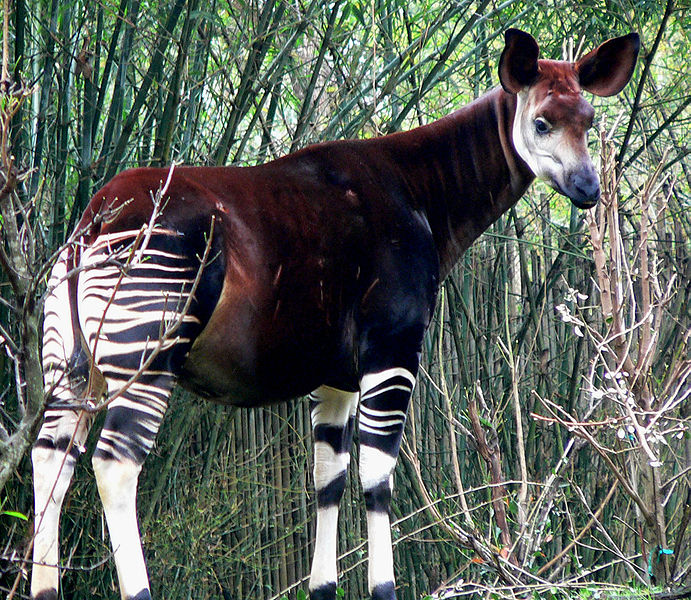OKAPI (oh-KAW-pee)
African
mammal related to the giraffe but smaller
Common clues:
Giraffe's
cousin; Relative of a giraffe; Congo rainforest denizen; African
ruminant; Animal with striped legs
Crossword
puzzle frequency:
2 times a year
Frequency
in English language:
34616 / 86800
Video: Strange
Zebra Horse Giraffe Cross Bred Okapi

The Okapi is a giraffid artiodactyl mammal native to the Ituri Rainforest, located in the northeast of the Democratic Republic of the Congo, in central Africa. Although the okapi bears striped markings reminiscent of the zebra, it is most closely related to the giraffe. Unknown to Europeans until 1901, today there are approximately 10,000–20,000 in the wild and only 40 different worldwide institutions display them.
Okapis have reddish dark backs, with striking horizontal white stripes on the front and back legs, making them resemble zebras from a distance. These markings are thought to help young follow their mothers through the dense rain forest; they also serve as camouflage in the wild.
Okapis prefer altitudes of 500 to 1,000 m, but may venture above 1,000 m in the eastern montane rainforests. Because there is a considerable amount of rain in these forests, okapis have an oily, velvety coat of fur that repels the water. They develop this coat early in childhood also as a technique of camouflage.
Okapis are herbivores, eating tree leaves and buds, grass, ferns, fruit, and fungi. Many of the plant species fed upon by the okapi are poisonous to humans.
The okapi was known to the ancient Egyptians; shortly after its discovery by Europeans, an ancient carved image of the animal was discovered in Egypt. For years, Europeans in Africa had heard of an animal that they came to call the 'African unicorn'.
An okapi at Bristol Zoo cleans itselfIn his travelogue of exploring the Congo, Henry Morton Stanley mentioned a kind of donkey that the natives called the 'Atti', which scholars later identified as the okapi. Explorers may have seen the fleeting view of the striped backside as the animal fled through the bushes, leading to speculation that the okapi was some sort of rainforest zebra.
As of 2010 there are about 160 specimens in zoos, making okapis in North American and Europen zoos reasonably common. Immediately following their discovery, zoos around the world attempted to obtain okapis from the wild. These initial attempts were accompanied by a high mortality rate due to the rigors and stress of traveling thousands of miles by boat and by train. In more recent years, shipment by airplane has proven more successful.
Although okapis are not classified as endangered, they are threatened by habitat destruction and poaching. The world population is estimated at 10,000–20,000. Conservation work in the Congo includes the continuing study of okapi behaviour and lifestyle, which led to the creation in 1992 of the Okapi Wildlife Reserve. The Congo Civil War threatened both the wildlife and the conservation workers in the reserve.
This article is licensed under the GNU Free Documentation License. It uses material from the Wikipedia article "Okapi".
|
|